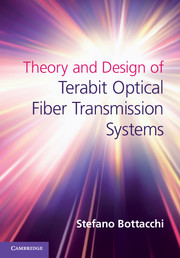Book contents
- Frontmatter
- Dedication
- Contents
- Preface
- Acknowledgments
- Part I Signals, spectra and optical modulations
- Part II Principles of light polarization and optical amplification
- Part III Interferometric optical modulators
- 8 Theory of the single-mode optical coupler
- 9 Theory and applications of the Mach–Zehnder interferometer
- 10 Interferometric optical responses
- 11 Chirp theory of the Mach–Zehnder modulator
- 12 Theory and modeling of the quadrature Mach–Zehnder modulator
- Part IV
- Appendix A Electromagnetic energy and power flow
- Appendix B Optical power and photon flux
- Index
12 - Theory and modeling of the quadrature Mach–Zehnder modulator
An enabling device for high-order optical modulation
from Part III - Interferometric optical modulators
Published online by Cambridge University Press: 05 September 2014
- Frontmatter
- Dedication
- Contents
- Preface
- Acknowledgments
- Part I Signals, spectra and optical modulations
- Part II Principles of light polarization and optical amplification
- Part III Interferometric optical modulators
- 8 Theory of the single-mode optical coupler
- 9 Theory and applications of the Mach–Zehnder interferometer
- 10 Interferometric optical responses
- 11 Chirp theory of the Mach–Zehnder modulator
- 12 Theory and modeling of the quadrature Mach–Zehnder modulator
- Part IV
- Appendix A Electromagnetic energy and power flow
- Appendix B Optical power and photon flux
- Index
Summary
Introduction
In this chapter, we will present the theory and mathematical modeling of the single-quadrature optical modulator, consisting of two optically coupled Mach–Zehnder modulators, as analyzed in Chapter 11.
Section 12.2 reviews the model of the Mach–Zehnder modulator (MZM), introducing new notation for the quadrature architecture. We will use the conventional terminology of “child” and “parent” MZMs, respectively for the inner and outer shell devices. Section 12.3 reports an original contribution to the field inversion method (FIM) used to calculate individual extinction ratios of child and parent MZMs, in the form of a non-destructive measuring procedure. The FIM is then verified by means of simulations of the SQMO under the required operating conditions. Section 12.4 develops an analytical model for the SQMO structure, providing the optical transfer function of each child versus the differential phase shift variable. Each child is characterized by the optical and electrical imbalances and the insertion loss at the optical carrier frequency. Expressions for the child phases at the SQMO outputs are derived and the quadrature condition is analyzed. Section 12.5 is devoted to the derivation of equations for the amplitudes and intensities of the child field phasors at the SQMO output ports, together with several useful functional parameters. Section 12.6 deals with the optical phases of both children and how they combine at the output port to generate the optical phase of the resulting field phasor. A general equation for the output phase is derived, requiring no conditions on the child fields. The new concepts of the twin-child MZM and the symmetric phase lattice are exploited, providing bias phase shift constraints on the quadrature phase condition.
- Type
- Chapter
- Information
- Theory and Design of Terabit Optical Fiber Transmission Systems , pp. 960 - 1060Publisher: Cambridge University PressPrint publication year: 2014



